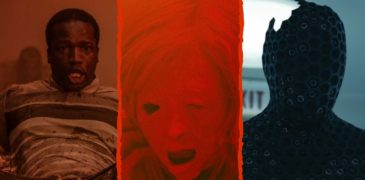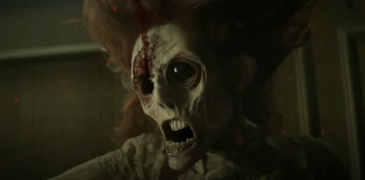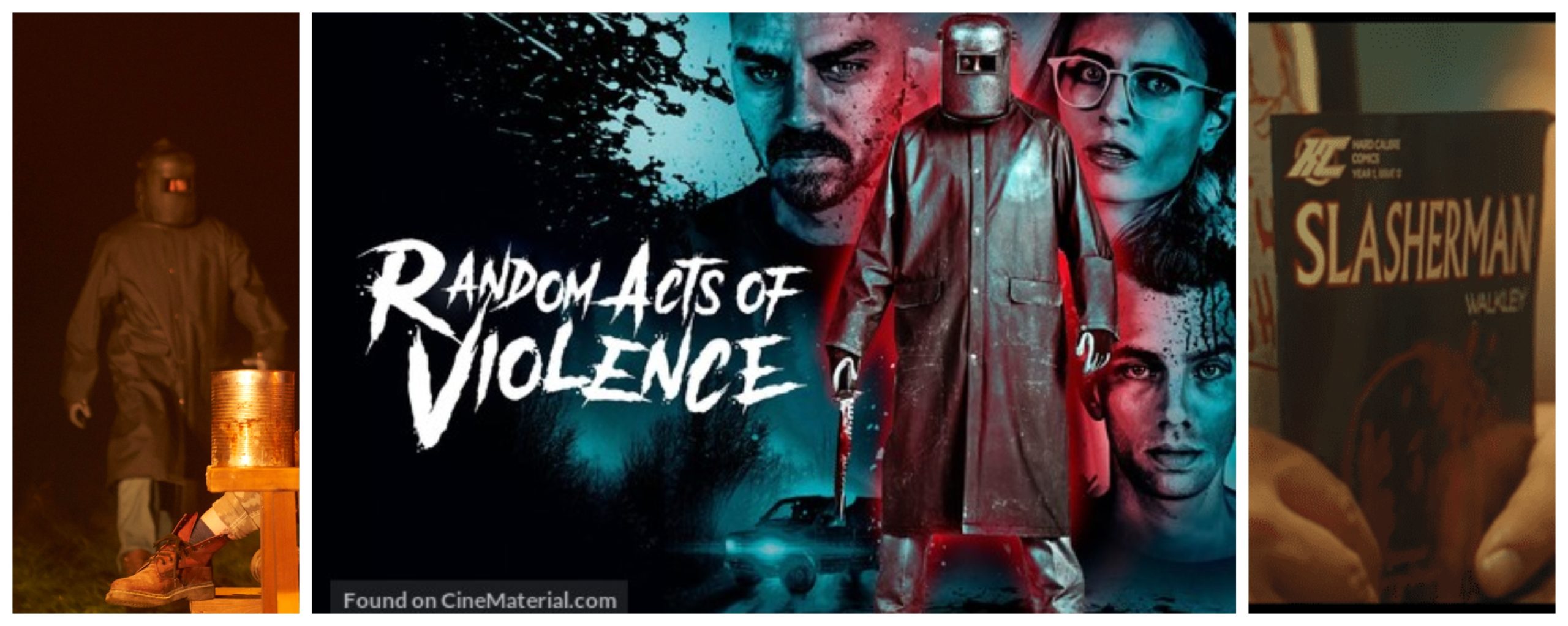
Slasher Horror With a Conscience
It’s no secret that as a society, we have become obsessed with serial killers. The most popular podcasts and television series over the past decade have explored the horrifying true crimes of killers who eluded detection long enough to gain infamy. We can’t get enough of it, even though we know the quiet guy next door could just as easily be the subject of the next Netflix special. But why? Some suggest that our fascination with serial killers is simply an expression of our biological drive to survive. “Predator inspection” is a survival tool employed by all dominant species; we study the behavior of things that can kill us and learn how to anticipate attacks in order to avoid them. Understanding serial killers can help us identify the patterns of a potential human threat, but we aren’t just learning from them. We’re enjoying their stories, we’re glorifying them.
In Random Acts of Violence (2019), writer/director Jay Baruchel and co-writer Jesse Chabot bring this distinction into question, forcing us to ask ourselves if enjoying human misery, even in fictional accounts, is wrong. Based on the 2010 comic Slasherman by Jimmi Palmiotti and Justin Gray, the film follows Todd (Jesse Williams, Cabin in the Woods), an exhausted comic book author who just wants to be done with the popular horror series that he and his producer/financier Ezra (Jay Baruchel) created, based on a real-life serial killer. He and Ezra embark on a road trip from their homes in Toronto to the New York Comic Con where Todd is scheduled to speak, traveling the infamous section of the American I-90 highway where the real-life Slasherman butchered and posed victims between 1989 and 1991. Todd’s girlfriend Kathy (Jordanna Brewster) comes along to interview Slasherman’s victim’s families for her own book, the premise of which is the main message of the film itself, that we glorify the killer but we never bother to learn who the victims were. Todd’s assistant Aurora (Niamh Wilson) rounds out the cast as the fourth passenger, playing an oddball who draws when she is upset. While Todd and Kathy debate over which is the more important story, the murderer or the victims, the killer they’re both writing about learns of Todd’s impending retirement and comes out of the shadows for one more bloody rampage.
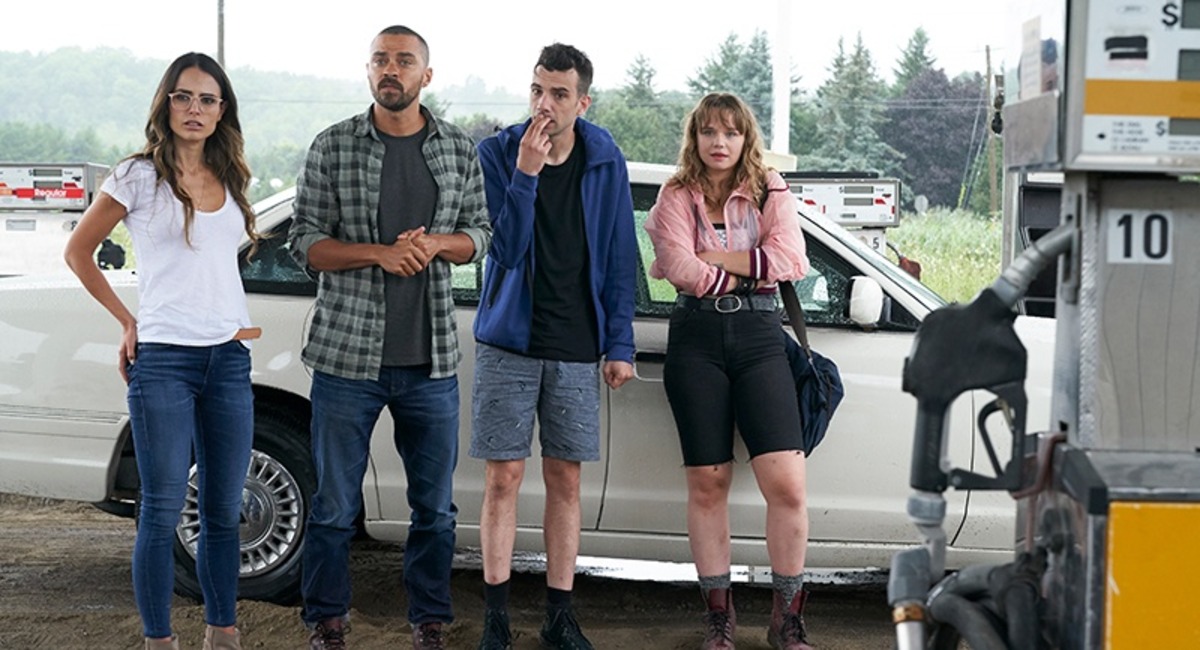
Baruchel is an iconic Canadian actor who came onto the scene as a child, co-hosting Popular Mechanics for Kids (1997-2000) alongside Elisha Cuthbert. Most people know him as the voice of Hiccup, the main character in the How to Train Your Dragon animated franchise, but he is a prolific actor with a wide range, having starred in both film and television series in almost every genre. He is the foul-mouthed comedic nerd in Knocked Up (2007), Tropic Thunder (2008), and Fanboys (2009), a young man who discovers his magical abilities with Nicolas Cage in The Sorcerer’s Apprentice (2010), the naive romantic in Man Seeking Woman (2015-2017), and the writer/director of Goon (2017), a sports comedy-drama starring Seann William Scott. Although Random Acts of Violence is not his directorial debut, it is his first crack at writing, directing, and starring in his favorite genre, horror.
Baruchel enjoys weaving an intelligent message into the script for those who are paying attention. He and co-writer Jesse Chabot spent 10 years finessing Random Acts of Violence, designing the slasher horror screenplay to be filmed in a unique way. They wanted to break conventional molds and remove any potential for guessing how a scene would end, taking away any audience’s pre-established expectations of the genre. In an interview with Kelly McNeely (iHorror), Baruchel described his approach to filming Random Acts of Violence as being intentionally unchoreographed.
“If you’ve ever watched a movie before, you can reasonably assume once a sequence has begun, when it’s going to end. When you’re in an action movie, and you know, guns come out, they start shooting or somebody hits the ignition on a car, I know that I’m in for four to seven minutes of this. When the killer takes his knife out, same fucking thing, right? And how is that scary? If you know that all you have to do is weather the storm for this finite period that’s coming based on 100 plus years of cinema, which has just taught me that every sequence is a self-contained thing unto itself. That gives you a control that I wanted the audience to not have.”

He describes our unspoken pact with society as being like a song that everyone knows. Every day, we wake up, the song begins, and we behave the same way. We obey societal rules like programmed robots, moving out of the way if someone is running past us, acknowledging strangers with a nod, and standing on the correct side of the escalator because that is what is expected of us. To Baruchel, this is a familiar song on repeat. As long as the song keeps playing, we will continue to behave the same way. He thinks that our reactions to what we watch in film and television are just as programmed, and he wants to stop the music.
In Random Acts of Violence, the audience is introduced to an angsty artist and eased into his relatively dull world, told what his problem is (that he wants to write his last comic book and move on), and given enough of the Slasherman back story that they should be able to predict where the film is going to go. Baruchel’s “societal expectations song” has begun. Comic book graphics are used to illustrate parts of the story that feels quirky and fun, and viewers relax into what they feel sure will be just another slasher film, if a little on the nerdy side. Conversations between the main character and his girlfriend establish a pre-existing rift between them before they ever get in the car, and when they do it’s obvious that the two characters riding with them will be the first to be killed off. It’s cliche on purpose.
The film moves along at an even pace with Todd and Ezra discussing Slasherman’s end and the destinations they need to hit on their way to Comic Con, but the lighting is subtly changing, setting the viewer off-kilter. Baruchel’s “song” begins to play like a stretched-out cassette (metaphorically speaking). The characters are all still playing along in their societal contracts, but the energy around them is degrading in a way that is almost unidentifiable to us. By the time the first kill happens, we are no longer sitting back munching our popcorn, we’re genuinely afraid for the victims. The camera is focused on them, getting to know them personally, picking up on their nervousness when they sense danger, and finally their fear when they realize what’s happening. The killer is secondary. The kill scenes themselves are bloody but not gory. They are terrifying because they are realistic. We can hear the knife stabbing through clothing and flesh, not a canned recording of something meant to sound like it. People are breathing realistically, not huffing and puffing for the camera. Their screams are what we would sound like if we were being attacked, not a silly, overly dramatic summer camp wail. And Baruchel’s “societal song” stops playing.
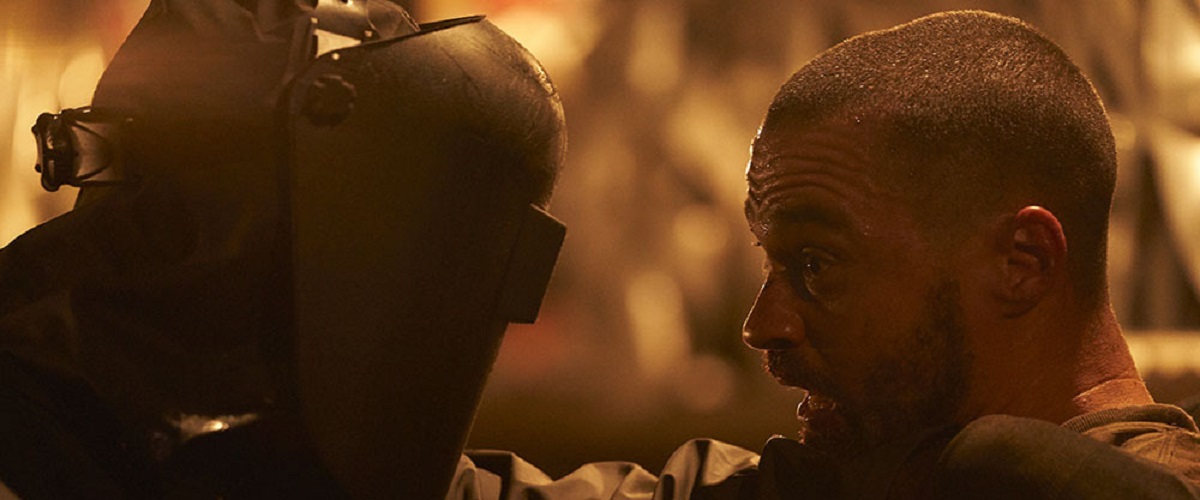
Now that we are truly paying attention, the story continues and is actually quite compelling. It effectively blends psychological horror, flashbacks, and realistic emotions with the horror of a serial killer awoken after years of silence when he learns that another installment of Slasherman is coming. The viewer now understands that they do not know what’s coming next and that being butchered on a dark highway is not entertainment. When a serial killer acts, real people die.
Random Acts of Violence manages to make the audience feel guilty for ever having taken pleasure in watching a character die on screen and questions our motives for binge-watching serial killer docuseries. Have we been completely desensitized to the reality of murder after decades of cinematic exploitation? Do we accept horror as entertainment because that’s just part of society’s familiar old song? And what would we do, personally, if that tape suddenly spooled out of its player and we had to look at what’s really happening around us? Would serial killers still be fun to watch if we knew their victims?
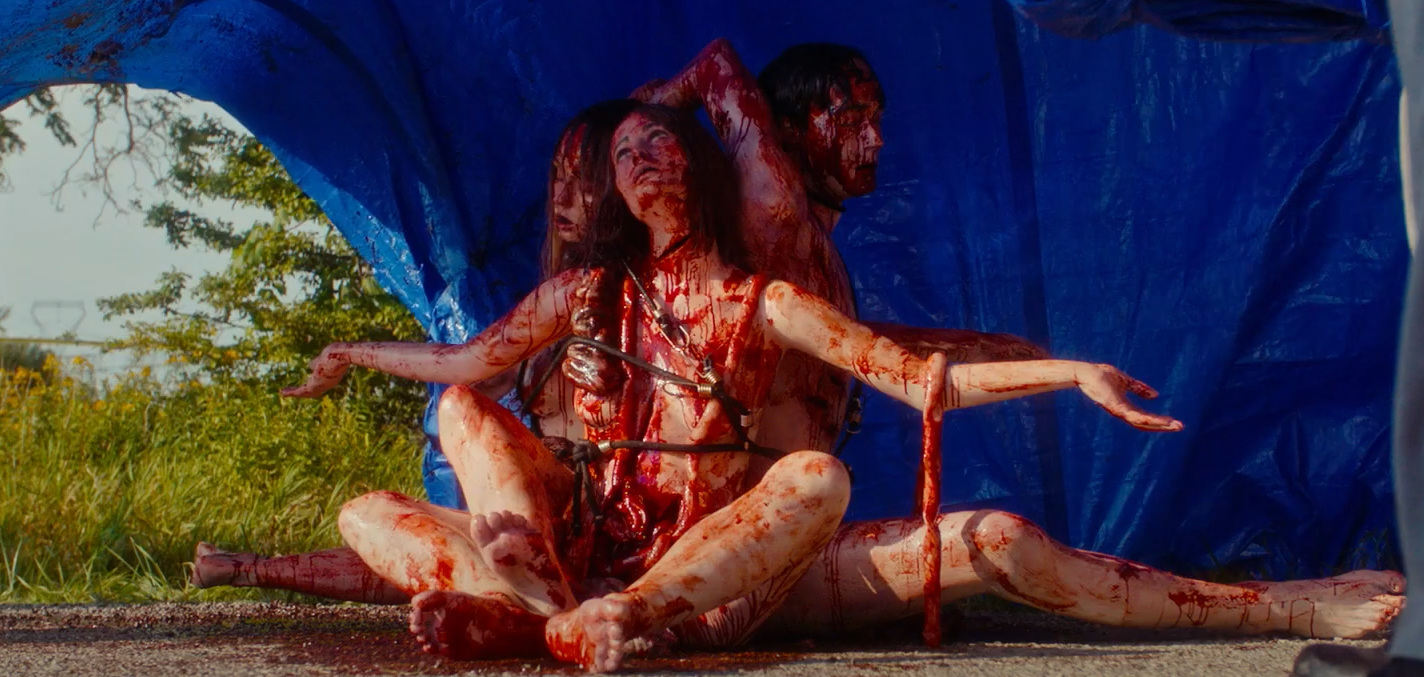
Cinematographer Karim Hussain (Hobo With a Shotgun) is a master, and his trademark style is a perfect match for the message Baruchel and Chabot wanted to impart. His constantly flowing Steadicam provides the POV of a detached watcher from the past, creating a haunted feeling that is amplified with the use of coloured lenses during psychologically intense moments. The film begins with a flashback to a Christmas in the past, and the smeared lighting of the Christmas tree from that scene is overlaid throughout the film to hint back to it without revealing the mystery until the end. The last scene is so visually overpowering due in large part to the lighting/coloring that it’s visceral. Baruchel’s personal answer to his own questions about our fascination with horror seem to unfold here, though that is just one interpretation.
Random Acts of Violence is a unique take on slasher horror that is equal parts fun to watch and emotionally awakening. Critics are divided, with some going as far as calling it insulting to horror fans, but for viewers who like a little medicine with their sugar, it’s a fantastic ride.
*The film debuted at the 2019 Fantastic Fest on September 19, 2019. It was released by Elevation Pictures in Canada on July 31, 2020, followed by a release in the United States on August 20, 2020, by Shudder.

More From Shudder
2020 has been a turbulent year, with many productions being delayed into 2021, or outright canceled. However, that did not stop some great films from coming out in 2020. Here… Synopsis: An aged mortician meets a young girl interested in working for him, as the two go about the duties of the job he relates the tragic stories of the deceased…. Coming-of-age stories with horror backdrops typically have the upper hand when it comes to bringing a unique vision due to the genre’s ability to tackle topics in ways that other… So often the horror genre seeks to hold a mirror up to society’s most profound and insidious anxieties. From concerns surrounding the development of nuclear weapons during the 1950s, as… RevBarely a year after Neil Marshall’s first big-budget Hollywood feature, Hellboy (2019), failed to earn him a box office success, he has returned to his horror roots with the much… The latest addition to Shudder’s original collection has fans highly polarized. Set in a remote luxury villa, with scenes many movie fans will recognize from the California desert, it’s a…The Grimoire of Horror Presents: The Best Films of 2020
The Mortuary Collection (2019) – Did That Guys Dick Just Explode?
Hellbender (2021) Film Review – A Curious Blend of Teenage Angst and Folk Horror
Revenge (2017) Film Review – A Subversive Take on a Final Girl
The Reckoning Review (2020) – Neil Marshall’s Return to Horror
The Seed (2022) Film Review – A Glitzy Shudder Original

Kate’s love of all things dark began as a child and deepened when she realized what being an adult meant. She was born with a pencil in her hand and loves nothing more than writing horrific stories to tantalize her inner demons. Kate lives in Hamilton, Ontario Canada with her husband and her boys, stirring up trouble wherever she can.
